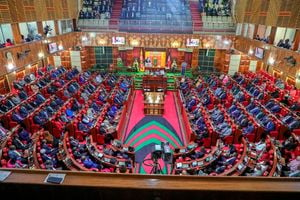
Human rights groups have reported that gang rape was the most common form of sexual violence in the 2017 General Election.
| ShutterstockNews
Premium
Rights groups say gang rape marred 2017 polls, warn on sexual violence during elections
What you need to know:
- Other sexual crimes committed included rape, defilement, genital mutilation, forced male circumcision and sexual exploitation.
- Of all rape cases documented, 19 per cent were raped by one perpetrator and 52.6 per cent by multiple perpetrators.
Human rights groups have warned about gender-based violence during this year’s campaigns as an investigation cited gang rape in past elections.
International Federation of Human Rights (FIDH) and the Kenya Human Rights Commission (KHRC) have reported that gang rape was the most common form of sexual violence in the 2017 General Election, and warned that sexual and gender based violence will be repeated this year should the state fail to act.
The report, titled: How Sexual and Gender Based Violence Mars Elections, explained that majority of survivors interviewed in Kisumu, Vihiga and Migori reported gang rape. Other sexual crimes included rape, defilement, genital mutilation, forced male circumcision and sexual exploitation.
Fact-finding missions were held in July and December 2018, and evidence collected from seven survivors in Kisumu County, 23 from Migori and 21 from Vihiga. Also interviewed were members of their households.
Data compiled by the Kenya National Commission on Human Rights (KNCHR) says that of all rape cases documented, 19 per cent were raped by one perpetrator and 52.6 per cent by multiple perpetrators. Half of the rapes documented in Kisumu and Bungoma counties were gang rapes.
Survivors in Vihiga said they were violated at the market, near a river, on the road or on their way back home, and in Migori, the crimes took place at Namba town, where most survivors worked.
At Obunga and Nyalenda in Kisumu, survivors were raped in their homes, and the perpetrators sometimes knocked at the door, used force and shouted. Almost all survivors reported having been raped without protection (condoms).
Survivors also recalled that the rape was accompanied by slapping, beatings, insults, gagging, strangulation, mouths being sealed or clasped, and being hit with objects or weapons.
In Vihiga and Migori, survivors indicated that they had been raped in front of their relatives, while in Kisumu, women reported that their husbands were either not present or had been evicted from the house by the police.
In some cases, the survivors were first robbed, while in others, rapists who were policemen, came in the guise of rescuers to earn the women’s trust.
Survivors in these areas also had challenges accessing health services for medical and psychological support.
In the 2007/2008 elections, 900 people were victims of sexual violence, according to the Commission of Inquiry into the Post-Election Violence (Cipev) report. The number, it said, was just the tip of the iceberg.
“This is because many victims could not reach hospitals due to lack of security or means of transport, and other victims who may have been raped and then killed were not factored in. victims may have also hesitated to report because of fear of stigmatisation or reprisals, risks of family rejection or social exclusion, lack of faith in the judicial system and costs of the proceedings,” said the commission.
“Sexual violence and sexual exploitation were also reported in Internally Displaced Person (IDP) camps, with allegations of women and girls being sexually exploited in exchange for food and other services... there were reports of individuals being sexually assaulted when they were trying to flee the violence, and others were forcibly displaced, lost family members, and lost their property,” added the report.
According to information collected by Cipev, victims of sexual violence were predominantly women from economically poor backgrounds. However, some men, particularly from the Luo ethnic group, were subjected to forced circumcision or genital mutilation, “carried out in a crude manner with objects such as broken glass”.
The exact number of victims of forced male circumcision, however, remains unknown as many victims did not report their attacks to the authorities and many of the victims were later killed or died from the bleeding.
As documentation efforts increased, human rights organisations realised that the crimes had, in some instances, been carefully planned and organised.
“It appeared that in some areas, sexual violence was perpetrated with the aim of forcing people to leave their homes or punishing them for voting or supporting the ‘wrong’ candidate,” noted the report.
Human rights violations
Women politicians were also targeted and faced the risk of rape, which was intended to instil fear in them, and intimidate them into dropping their political bids.
However, more than 80 per cent of victims in Nairobi, Nakuru and Eldoret did not report the crimes to the police, in some cases, because the police were the perpetrators, they did not trust the institution, or because they were unable to identify those responsible.
The report explained that even though the peace that was preached all over the country in 2013 minimised violence, it did not prevent political violence against female candidates, only serving to obstruct justice efforts.
Another 2018 report by KNCHR showed that at least 201 people, mostly women and girls, had experienced sexual violence in the 2017 elections, while noting that the figure was probably a low estimate. Accounting for 25.17 per cent of all the human rights violations documented, it was the second most common form of electoral violence after physical injuries.
The commission had documented cases during political party primaries, campaigns, and polling days on August 8, and October 26, 2017, in 11 counties, including Vihiga, Migori and Kisumu, where FIDH and KHRC conducted fact-finding missions.
They estimated that the vast majority of survivors were women (over 96 per cent), men aged up to 68, (over 3 percent), and the remaining percentage affecting children as young as seven.
As in the 2007 and 2008 elections, cases of rape, including gang rape with up to six perpetrators, were documented. Once again, violence also took place in survivors’ homes, in the presence of family members, including children, and half of the survivors lived in informal settlements.
KNCHR further found that police comprised 54.5 per cent of perpetrators and civilians were 45.5 per cent. Gender-based violence, in particular against women politicians, was also reported.
“Researchers stressed that during the 2017 General Election, female politicians fought one of the ‘most violent campaigns in the history of Kenya’s elections’, with cases of women candidates facing beatings, being robbed with machetes and batons and threatened with public stripping,” said the report.
“Cases of women politicians who experienced burning of their houses, killing of their bodyguards, or were held hostage in exchange for money, were also reported. In addition, there were many cases of women candidates facing rumours and allegations of sexual misconduct, fuelled by political rivals,” it added.
The report noted that the search for justice had been hampered by practical and legal impediments.
These include the fact that legal remedies under Kenyan law are heavily reliant on a survivor coming forward and filing a formal report with the police and providing forensic evidence. This enables the Office of the Director of Public Prosecutions (ODPP) to be seized of the case and introduces the survivor to the judicial system.
Other barriers include the police pointing to lack of adequate evidence or the inability to identify perpetrators to justify the absence of investigation and prosecution for sexual violence cases. At other times, police are unwilling to initiate investigations despite available information on the large-scale occurrence of sexual violence.
“In Kisumu, survivors who attempted to report their case to the police said that they faced resistance, and others indicated that the police were unwilling or unable to provide them with the necessary support.”
Worse still, the survivors have to contend with physical, psychological, social and economic consequences. Physical consequences include injuries to reproductive organs, sexually transmitted infections, eye injury, backache and abdominal pains, hypertension and ulcers.
Psychological consequences range from post-traumatic disorders, insomnia, anxiety disorders, phobia towards men in uniform, denial, fear of attack, stigma. Survivors also isolate themselves, and some fear being deserted by spouses.
Some of the survivors have also lost livelihoods, business capital, and retirement investments. Their children may have also dropped out of school. They also face high cost of treatment, sanctions from spouses to avoid public exposure, and perpetual discrimination in relation to economic opportunities in the community.
Political consequences include women losing interest in participating in the electoral processes. Some survivors indicated they would not vote again, fearing for their lives and those of their families.





